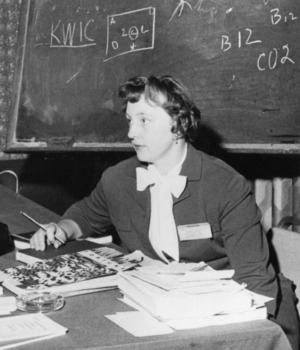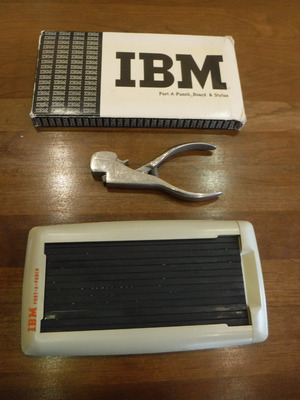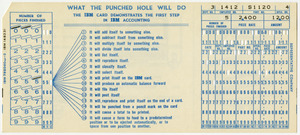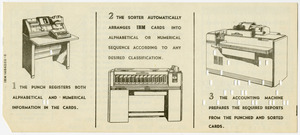Claire Kelly Schultz facts for kids
Quick facts for kids
Claire Kelly Schultz
|
|
|---|---|
 |
|
| Born | November 17, 1924 |
| Died | May 28, 2015 (aged 90) Line Lexington, Pennsylvania, U.S.A.
|
| Nationality | American |
| Alma mater | Juniata College, Drexel Institute |
| Spouse(s) | Wallace L. Schultz |
| Awards | ASIS Award of merit, 1980 |
| Scientific career | |
| Fields | Information science |
| Institutions | Merck, Sharp and Dohme; Institute for Advancement of Medical Communications |
Claire Kelly Schultz (November 17, 1924 – May 28, 2015) was a very important person in the early days of computers. She helped create systems that could automatically find and organize information. This field is now called information science.
Claire was known as a "documentalist." This means she specialized in organizing documents and information. She was especially good at building "thesauri" (like a dictionary of related terms) and using machines to help index information. She invented new ways to use punch cards to find information.
While working as a librarian at a company called Merck, Sharp and Dohme, she made a system using punch cards. This system could sort cards and find information using "Boolean logic." This is a way of searching using "and," "or," and "not" to combine search terms. Her work with punch cards in 1949 was a big step towards using computers for finding information later on.
Early Life and Education
Claire Kelly was born on November 17, 1924, in Etters, Pennsylvania. She grew up in a small town. She went to a one-room school and finished 8th grade when she was only 12 years old.
When she was 13, her family moved to a farm. Claire helped a lot with housework and farm animals while still going to school. At 15, she worked as a governess and cook for another family. She did this to earn money for college.
Claire finished high school at age 16. She then went to Juniata College with a four-year scholarship. She also worked for a German family to pay for her room and food. In 1944, at age 19, she earned her degree in Chemistry and Biology, with a minor in Mathematics. She had planned to become a doctor.
Claire wanted to go to medical school. She applied to the Woman's Medical College of Pennsylvania. At first, they said no because she was too young. For a year, she worked at a hospital helping mental patients. This was part of a program by the Quakers to treat patients kindly.
At the hospital, she met Wallace L. Schultz, who would become her husband. They got married in June 1945. Claire was then accepted into medical school. However, due to the rules of the time, she decided to leave medical school to focus on her family. For much of their marriage, Claire was the main person earning money, while Wallace took care of their children and home.
Career in Information Science
Claire Schultz had many different jobs during her career. She worked as a computer expert, a librarian, a researcher, and a professor. From 1946 to 1948, she worked at the Wistar Institute of Anatomy and Biology. She started as a librarian but soon became a lab assistant. She helped study human reproduction.
In 1948, she got a better-paying job as a librarian at Sharp & Dohme. This company later became part of Merck, Sharp & Dohme. There, she met Calvin Mooers, who believed in a system for indexing information called the Zator system. Claire was inspired by his ideas.
She created a "subject dictionary" to organize the words used in science papers and by the company's scientists. She and Robert Ford tried out new ways to search for information. They used a machine called the Remington Rand sorter and Boolean logic. They convinced the company that an IBM 101 machine could be used for punch card searches. This machine could search using "and," "or," and "not" connections.
While working, Claire also studied library science at Drexel University. She used her work on library sorting as her master's thesis. In 1952, she earned her master's degree in Library Science. A famous computer scientist named John Mauchly was impressed by her work. He offered her a job. She stayed at Merck Research Laboratories until 1957.
In 1957, Schultz left Merck to work with John Mauchly at Sperry Rand Univac Corporation. She worked on research about finding information from 1958 to 1961.
In the early 1960s, Claire helped automate the Armed Services Technical Information Agency (ASTIA). She also helped develop the plans for the MEDLARS/MEDLINE system. This system is used by the National Library of Medicine to find medical information.
From 1961 to 1970, she worked for the Institute for the Advancement of Medical Communication. She also taught classes and helped students at Drexel University. In 1962, she taught the first class at Drexel on "documentation," which was about how to find information. She is known for helping to start Drexel's information science program in 1963.
In 1962, she became the first female president of the American Documentation Institute. This organization is now called the Association for Information Science and Technology. She also helped start Information Science Abstracts, a publication that summarizes new research.
From 1973 to 1982, she was a professor of Information Science and the Director of Libraries at the Medical College of Pennsylvania. She helped create the Florence A. Moore Library of Medicine there.
Claire Schultz was one of the first people to write about the history of information science. Her important papers are kept at the Charles Babbage Institute. She saw the very beginning of the "information age." When the Internet came along, she thought it was like "a huge, formless haystack" where it would be hard to find specific things. She believed it would make searching databases very complex.
Claire Schultz passed away on May 28, 2015, from Alzheimer's disease.
Awards
- ASIS Award of Merit, American Society for Information Science, 1980
See also
 In Spanish: Claire Kelly Schultz para niños
In Spanish: Claire Kelly Schultz para niños




